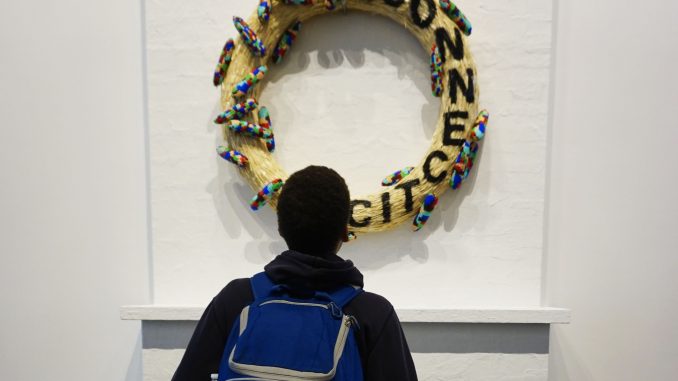
Every year during Anissa Mack’s childhood in the 1970s and ‘80s, her relatives gathered for a family “holiday” — participating in Connecticut’s annual Durham Fair and its craft and food competitions.
“My sister and I always entered different [craft] categories,” said Mack, a 1996 MFA sculpture alumna. “Both my parents were from [Durham] so everyone would come back from out of town. It was kind of like a holiday for our family.”
In 1996, Mack spent the summer after she graduated preparing pieces for the fair, entering a craft in every single one of the 73 categories, which could be anything as vague as “metalwork.” In 2006, she entered in all 69 categories and crafted objects like a porcelain doll.
Now, Mack reflects on her post-graduate project and pays homage to the state fair through the exhibit “Junk Kaleidoscope,” a collection of fair-inspired sculptures and objects on display at the Aldrich Contemporary Art Museum in Ridgefield, Connecticut, through April 22.
Founded in 1916, Connecticut’s Durham Fair has grown from a small one-day event on the Durham Town Green to a four-day, multi-acre festival recognized as one of the largest of its kind in the state. The fair hosts a wide range of events for all ages, including music performances, animal shows and food and craft competitions.
Mack takes a more abstract approach to the items created for her own artistic version of a state fair’s craft competition.
“[The fair] was a real influence in making things, and thinking about this categorization and repetition, which has always been strangely important to my work,” Mack said.
“Junk Kaleidoscope” consists of 24 new craft pieces that Mack created in the past two years. The objects range from neon-dyed jeans and a plexiglass flower wreath to a foil-covered model hand grasping strands of pasta.
In addition to the crafts themselves, a floor-to-ceiling poster in the exhibit presents a list of 70 categories that inspired the pieces. The list is an imitation of the craft categories in the Durham Fair’s competition.
Mack’s list includes some real categories that have appeared in the Durham Fair, like “Lamp, any size or style” or “painting on fabric, paper or wood,” as well as more conceptual ones she invented, like “My heart wants more.”
“The list serves as an interpretive device for the viewer,” said Amy Smith-Stewart, a curator at the Aldrich.
Smith-Stewart said the name “Junk Kaleidoscope” refers to how objects can be endlessly rearranged and given new meaning.
After growing up one town over from Durham in Guilford, Connecticut, Mack continued crafting as a sculpture and ceramics undergraduate student at Wesleyan University. Mack said Wesleyan’s liberal arts education helped her learn about the depth of art, but Tyler helped her find her passions.
“Tyler really helped me to focus and think about what kind of things I wanted to make,” Mack said. “What are the things that are interesting me? What are the questions I’m trying to ask? What are the processes I enjoy doing?”
It is these questions that brought her back to exploring a memory she connected with most: the fair.
To better reflect the collaborative nature of the fair, Mack decided to give members of the Aldrich community the chance to re-curate the show in January. With the help of the Aldrich, Mack chose 18 people of all ages and backgrounds to come to her studio, hear about her process and physically rearrange the show, after which they will have a second opening.
“[This process] mirrors the fair because it allows my objects to be judged,” Mack said. “It relates back to the list itself and how [people] associate different objects with different categories or how they associate the pieces with each other.”
Mack hopes that her show will be memorable not only for the connections viewers have with the pieces, but also with their vagueness.
“I don’t want to create things that people are able to categorize very quickly,” Mack said. “To make an object that you can’t classify is a pretty good accomplishment.”


Be the first to comment